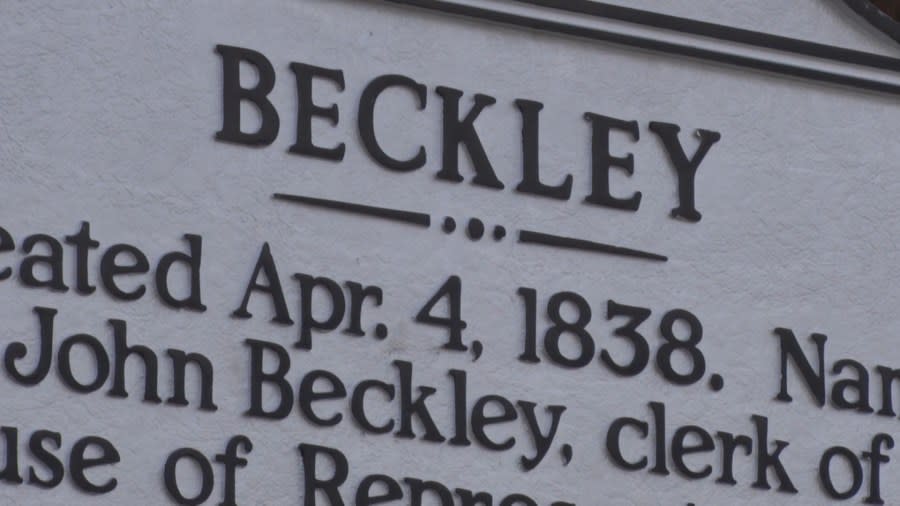Old Bluestone Road historical marker dedication to take place at Wildwood House

- Oops!Something went wrong.Please try again later.
BECKLEY, WV (WVNS) — A state historical marker ceremony will be held at Wildwood House in Beckley on Saturday, May 18, 2024.
The dedication of the marker, commemorating Old Bluestone Road, will take place in tandem with annual Founder’s Day observances. Old Bluestone Road was the “main road” in the area prior to 1848.
The marker was obtained through a William G. Pomeroy Foundation History Grant. Following an intensive vetting process, the foundation pays all fabrication and shipping costs. City of Beckley officials and the Raleigh County Historical Society (RCHS) will deliver remarks.
“Old Blue” as it was called by city and county founder Alfred Beckley, was integral to opening the southern (West) Virginia wilderness to European settlement and development. This was a part of Fayette County, as Raleigh County was not created until 1850.
New historical marker will be placed to commemorate the Giles, Fayette, and Kanawha Turnpike
Fayette County resembled the country’s desolate Western frontier than its bustling sea coast. In Alfred Beckley’s history of the county, he wrote of the atmosphere when he arrived in 1835: “This section of the country was then a perfect wilderness, full of deer, bear, swarms of pestiferous gnats… Our wilderness was inhabited by a few families, miles apart.”
County historian Jim Wood remarked that Farley’s Trace is typically recognized as the “grandaddy” of Raleigh County roads. In 1797 to 1798, Francis Farley cleared “a path six feet wide” from the ford of Bluestone River (near present day Hinton) to the place where Louisa, Kentucky stands now, approximately 150 miles. Later roads would follow at least a portion of this path.
In 1811, the Virginia General Assembly approved a “salt road” that connected the Kanawha River salines with customers in the area of southwestern Virginia. Salt, a crucial food preservative, had to be purchased on the Atlantic seaboard and hauled by a wagon to western Virginia prior to this. In 1797, it became available “locally” when entrepreneurs began production from the Kanawha salines.
New Salem Baptist Church listed on National Register of Historic Places
The Old Bluestone Road was finished no later than 1812, and ran from “the mouth of Bluestone on New River to the mouth of Loop Creek on the Kanawha.” It was deemed “primitive… but better than nothing.” The first white settlers of the county were given access by this road, which served as the main route to the interior until 1848.
Alfred Beckley once described the road as “‘running amuck’ at all mountains, hills, hollows, ascents and descents, and all streams… passing the… 23 mile tree from Pack’s Ferry, where the road forked, the direct straight forward leading to Kanawha, and the road to the left leading to Logan and Guyandotte rivers. [It required] three of four days laborious pulling for a wagon and team to go from 23rd mile tree to the Kanawha river.”
Residents of the county were in need of a more useful road for the transportation of products and supplies. They united with residents along the Kanawha in sponsoring the Giles, Fayette, and Kanawha (GF&K) Turnpike company. The Virginia Assembly passed an act incorporating the company on March 1, 1837. As the GF&K Turnpike neared completion, the Old Bluestone Road become obsolete.
Mountain State Destinations: Grave Creek Mound
“Old Blue” is featured in another piece of country heritage, the mystery of Ferguson Rock. The lore of the area holds that a man named S. Ferguson was thrown from his horse as he crossed Piney Creek, close to where the city sewage treatment plant now sits.
Having lost his steed, broken his leg, and becoming unable to move, the young man stoically accepted his fate and determined to leave a message for any searchers. He carved on a large rock near where he lay: “S. Ferguson F[ayette] County 1814.”
Curiously, the number “4” was reversed in the date. His family later allegedly found his body, buried it in a nearby unmarked grave and returned home, leaving the rock in the creek.
Less poetic but more probable is the version of events recorded by early county historian, Winton A. Riffe. Riffe contended “S. Ferguson” was likely a member of the “noted Ferguson fur-trapping family” of Franklin County, Virginia. If so, the rock more likely marked a hunting camp than a death site.
Cass Scenic Railroad bringing back rides to ‘Ghost Town of Spruce’ starting next week
Though the inscription’s meaning is disputed, there is one historically significant point: the date inscribed on the rock is nearly four decades prior to the formation of Raleigh County from Fayette County in 1850. Thus, Ferguson Rock is one of the county’s earliest known artifacts.
The rock was moved to a private residence in Beckley in 1984, where it remained until RCHS arranged donation to the City of Beckley in November 2017. Following a short period of storage, the rock was placed on the lawn of Wildwood House, the historic residence of Alfred Beckley.
The Old Bluestone Road marker is the 37th installation under the RCHS program since it began in 2016.
For the latest news, weather, sports, and streaming video, head to WVNS.

